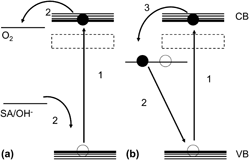Crossref Citations
This article has been cited by the following publications. This list is generated based on data provided by
Crossref.
Johansson, Malin B
Baldissera, Gustavo
Valyukh, Iryna
Persson, Clas
Arwin, Hans
Niklasson, Gunnar A
and
Österlund, Lars
2013.
Electronic and optical properties of nanocrystalline WO3thin films studied by optical spectroscopy and density functional calculations.
Journal of Physics: Condensed Matter,
Vol. 25,
Issue. 20,
p.
205502.
Johansson, Malin B.
Zietz, Burkhard
Niklasson, Gunnar A.
and
Österlund, Lars
2014.
Optical properties of nanocrystalline WO3 and WO3-x thin films prepared by DC magnetron sputtering.
Journal of Applied Physics,
Vol. 115,
Issue. 21,
Zhang, Feng
Wang, Hai-Qian
Wang, Song
Wang, Jing-Yang
Zhong, Zhi-Cheng
and
Jin, Ye
2014.
Structures and optical properties of tungsten oxide thin films deposited by magnetron sputtering of WO
3
bulk: Effects of annealing temperatures
.
Chinese Physics B,
Vol. 23,
Issue. 9,
p.
098105.
Anil Kumar, C.
Santhosh Kumar, T.
and
Pamu, D.
2015.
Irreversible thermochromic response of RF sputtered nanocrystalline BaWO4 films for smart window applications.
AIP Advances,
Vol. 5,
Issue. 10,
Bondarenko, N.
Eriksson, O.
and
Skorodumova, N. V.
2015.
Polaron mobility in oxygen-deficient and lithium-doped tungsten trioxide.
Physical Review B,
Vol. 92,
Issue. 16,
Mehmood, Faisal
Pachter, Ruth
Murphy, Neil R.
Johnson, Walter E.
and
Ramana, Chintalapalle V.
2016.
Effect of oxygen vacancies on the electronic and optical properties of tungsten oxide from first principles calculations.
Journal of Applied Physics,
Vol. 120,
Issue. 23,
Qian, Jingwen
Zhao, Zengying
Shen, Zhenguang
Zhang, Guoliang
Peng, Zhijian
and
Fu, Xiuli
2016.
Oxide vacancies enhanced visible active photocatalytic W19O55NMRs via strong adsorption.
RSC Advances,
Vol. 6,
Issue. 10,
p.
8061.
Amrollahi, Rezvaneh
Wenderich, Kasper
and
Mul, Guido
2016.
Room Temperature Oxidation of Ethanol to Acetaldehyde over Pt/WO3.
Advanced Materials Interfaces,
Vol. 3,
Issue. 18,
Huotari, Joni
Kekkonen, Ville
Haapalainen, Tomi
Leidinger, Martin
Sauerwald, Tilman
Puustinen, Jarkko
Liimatainen, Jari
and
Lappalainen, Jyrki
2016.
Pulsed laser deposition of metal oxide nanostructures for highly sensitive gas sensor applications.
Sensors and Actuators B: Chemical,
Vol. 236,
Issue. ,
p.
978.
Leidinger, Martin
Huotari, Joni
Sauerwald, Tilman
Lappalainen, Jyrki
and
Schütze, Andreas
2016.
Selective detection of naphthalene with nanostructured WO<sub>3</sub> gas sensors prepared by pulsed laser deposition.
Journal of Sensors and Sensor Systems,
Vol. 5,
Issue. 1,
p.
147.
Dong, Yunbing
Xiong, Chunrong
Zhang, Yilu
Xing, Shuai
and
Jiang, Hong
2016.
Lithium-titanate-nanotube-supported WO3for enhancing transmittance contrast in electrochromics.
Nanotechnology,
Vol. 27,
Issue. 10,
p.
105704.
DohĿeviĿ-MitroviĿ, Zorana
StojadinoviĿ, Stevan
Lozzi, Luca
AškrabiĿ, Sonja
RosiĿ, Milena
TomiĿ, Nataša
PaunoviĿ, Novica
LazoviĿ, Saša
NikoliĿ, Marko G.
and
Santucci, Sandro
2016.
WO3/TiO2 composite coatings: Structural, optical and photocatalytic properties.
Materials Research Bulletin,
Vol. 83,
Issue. ,
p.
217.
Johansson, M B
Kristiansen, P T
Duda, L
Niklasson, G A
and
Österlund, L
2016.
Band gap states in nanocrystalline WO3thin films studied by soft x-ray spectroscopy and optical spectrophotometry.
Journal of Physics: Condensed Matter,
Vol. 28,
Issue. 47,
p.
475802.
Gerosa, Matteo
Di Valentin, Cristiana
Onida, Giovanni
Bottani, Carlo Enrico
and
Pacchioni, Gianfranco
2016.
Anisotropic Effects of Oxygen Vacancies on Electrochromic Properties and Conductivity of γ-Monoclinic WO3.
The Journal of Physical Chemistry C,
Vol. 120,
Issue. 21,
p.
11716.
Zhang, Yu
Peng, Zhijian
and
Fu, Xiuli
2017.
Controlled synthesis and photocatalytic performance of waxberry-like Ni11(HPO3)8(OH)6 microballs.
Journal of Materials Research,
Vol. 32,
Issue. 14,
p.
2819.
Abdel Samad, B.
and
Ashrit, P.V.
2017.
The dependence of electrical conductivity on temperature for dry lithiated crystalline tungsten trioxide thin films.
Solid State Ionics,
Vol. 308,
Issue. ,
p.
156.
Johansson, Malin B.
Mattsson, Andreas
Lindquist, Sten-Eric
Niklasson, Gunnar A.
and
Österlund, Lars
2017.
The Importance of Oxygen Vacancies in Nanocrystalline WO3–x Thin Films Prepared by DC Magnetron Sputtering for Achieving High Photoelectrochemical Efficiency.
The Journal of Physical Chemistry C,
Vol. 121,
Issue. 13,
p.
7412.
Abdel Samad, B.
and
Ashrit, P.V.
2017.
Optimization of mixed conductivity through nanostructure control in WO3 thin films.
Thin Solid Films,
Vol. 636,
Issue. ,
p.
717.
Poongodi, S.
Kumar, Palaniswamy Suresh
Mangalaraj, D.
Ponpandian, N.
Meena, P.
Masuda, Yoshitake
and
Lee, Chongmu
2017.
Electrodeposition of WO 3 nanostructured thin films for electrochromic and H 2 S gas sensor applications.
Journal of Alloys and Compounds,
Vol. 719,
Issue. ,
p.
71.
Top, Işıl
Binions, Russell
Sol, Christian
Papakonstantinou, Ioannis
Holdynski, Marcin
Gaiaschi, Sofia
and
Abrahams, Isaac
2018.
Improved thermochromic properties in bilayer films of VO2with ZnO, SnO2and WO3coatings for energy efficient glazing.
Journal of Materials Chemistry C,
Vol. 6,
Issue. 46,
p.
12555.
